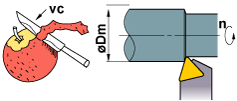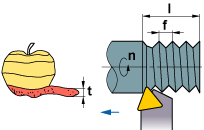
|
|
- Technical Information
- Formulae for cutting power
FORMULAE FOR CUTTING POWER
CUTTING SPEED (Pc)

*Divide by 1000 to change to m from mm.
- vc (m/min)
- Cutting speed
- Dm (mm)
- Workpiece Diameter
- π (3.14)
- Pi
- n (min-1)
- Main Axis Spindle Speed

(Problem)
What is the cutting speed when main axis spindle speed is 700min-1 and external diameter is Ø50? Substitute π=3.14, Dm=50, n=700 into the formula.
(Answer)
Substitute π =3.14, Dm=50, n=700 into the formula.
What is the cutting speed when main axis spindle speed is 700min-1 and external diameter is Ø50? Substitute π=3.14, Dm=50, n=700 into the formula.
(Answer)
Substitute π =3.14, Dm=50, n=700 into the formula.
vc=(π×Dm×n)÷1000=(3.14×50×700)÷1000 =110 (m/min)
Cutting speed is 110 m/min.
Cutting speed is 110 m/min.
FEED (f)

- f (mm/rev.)
- Feed per revolution
- l (mm/min)
- Cutting length per Min
- n (min-1)
- Main Axis Spindle Speed

(Problem)
What is the feed per revolution when main axis spindle speed is 500min-1 and cutting length per minute is 120mm/min ?
(Answer)
Substitute n=500, I=120 into the formula.
What is the feed per revolution when main axis spindle speed is 500min-1 and cutting length per minute is 120mm/min ?
(Answer)
Substitute n=500, I=120 into the formula.
f=l÷n=120÷500=0.24 (mm/rev)
The answer is 0.24 mm/rev.
The answer is 0.24 mm/rev.
CUTTING TIME (Tc)

- Tc (min.)
- Cutting Time
- lm (mm)
- Workpiece Length
- l (mm/min)
- Cutting Length per Min.
(Problem)
What is the cutting time when 100mm workpiece is machined at 1,000min-1, with feed=0.2mm/rev?
(Answer)
First, calculate the cutting length per min. from the feed and spindle speed.
What is the cutting time when 100mm workpiece is machined at 1,000min-1, with feed=0.2mm/rev?
(Answer)
First, calculate the cutting length per min. from the feed and spindle speed.
l=f×n=0.2×1000=200(mm/min)
Substitute the answer above into the formulae.
Tc=lm÷l=100÷200=0.5(min)
0.5×60=30(sec.) The answer is 30 seconds.
Substitute the answer above into the formulae.
Tc=lm÷l=100÷200=0.5(min)
0.5×60=30(sec.) The answer is 30 seconds.
THEORETICAL FINISHED SURFACE ROUGHNESS (h)

- h (µm)
- Finished Surface Roughness
- f (mm/rev.)
- Feed per Revolution
- Re (mm)
- Insert Corner Radius

(Problem)
What is the theoretical finished surface roughness when the insert corner radius is 0.8mm and feed is 0.2 mm/rev ?
(Answer)
Substitute f=0.2 mm/rev, R=0.8 into the formulae.
What is the theoretical finished surface roughness when the insert corner radius is 0.8mm and feed is 0.2 mm/rev ?
(Answer)
Substitute f=0.2 mm/rev, R=0.8 into the formulae.
h=f2÷(8×Re)×1000=0.22÷(8×0.8)×1000=6.25µm
The theoretical finished surface roughness is 6 µm.
The theoretical finished surface roughness is 6 µm.